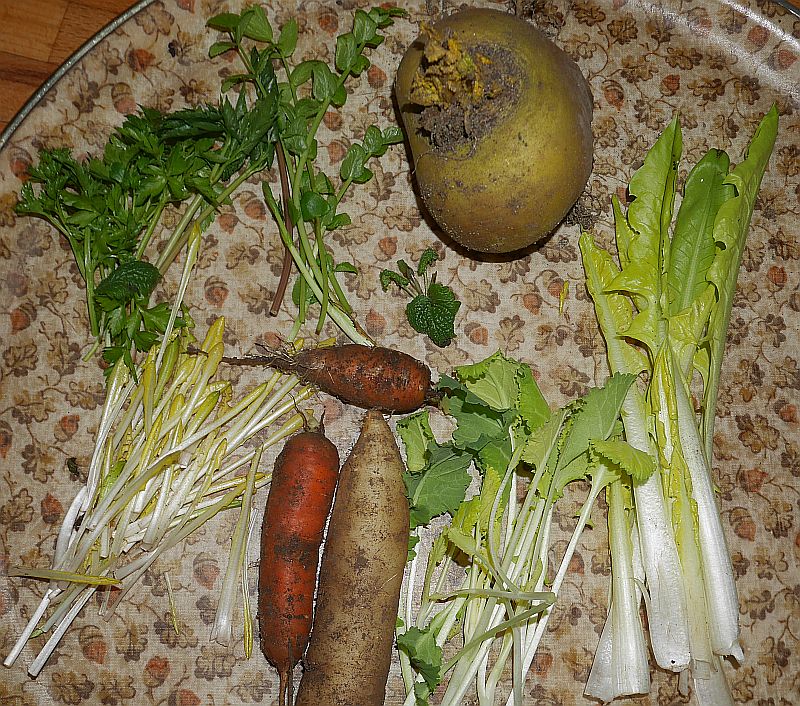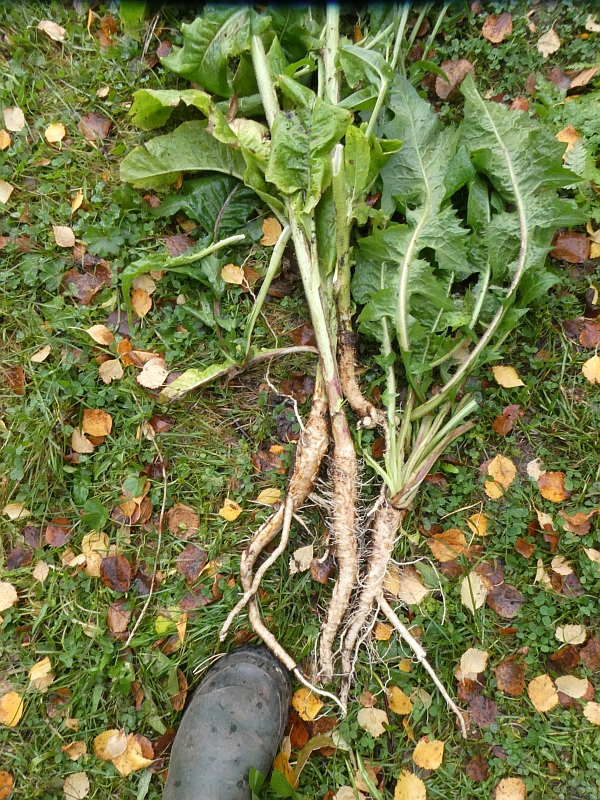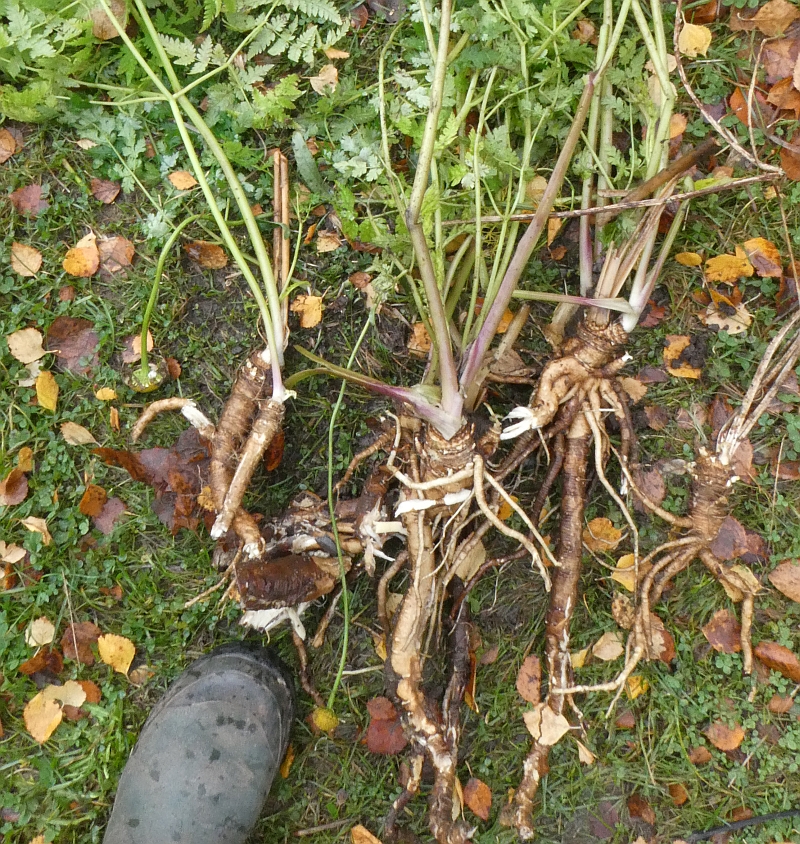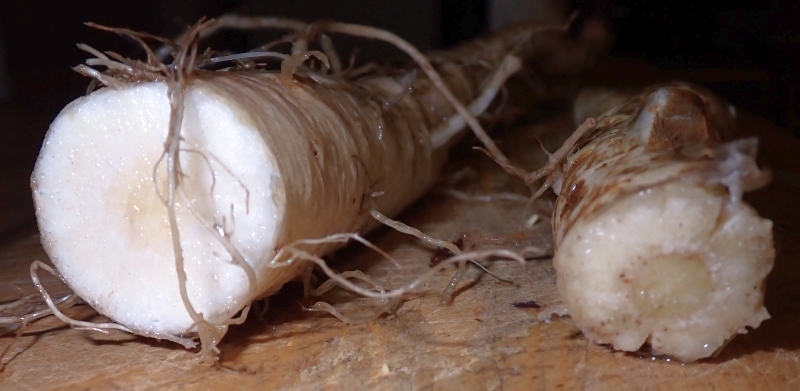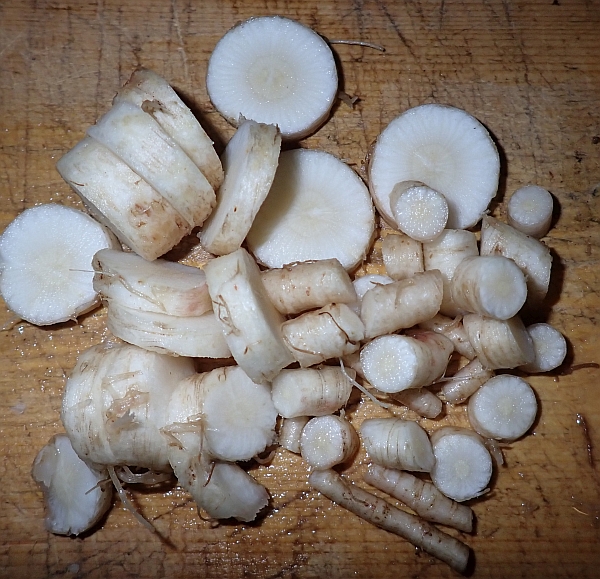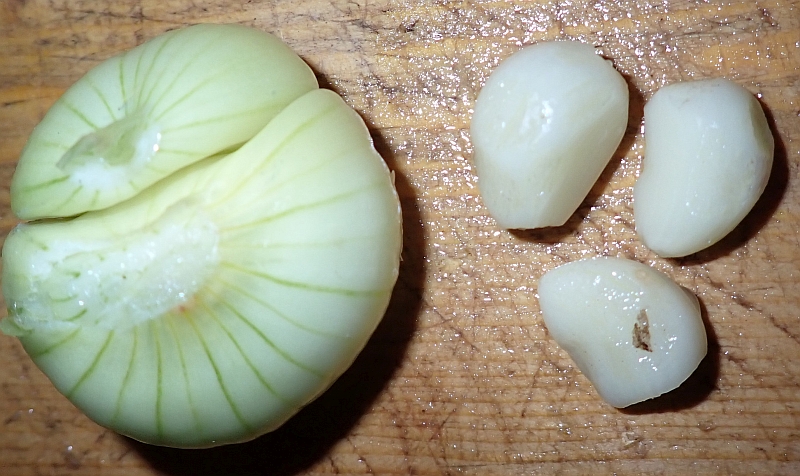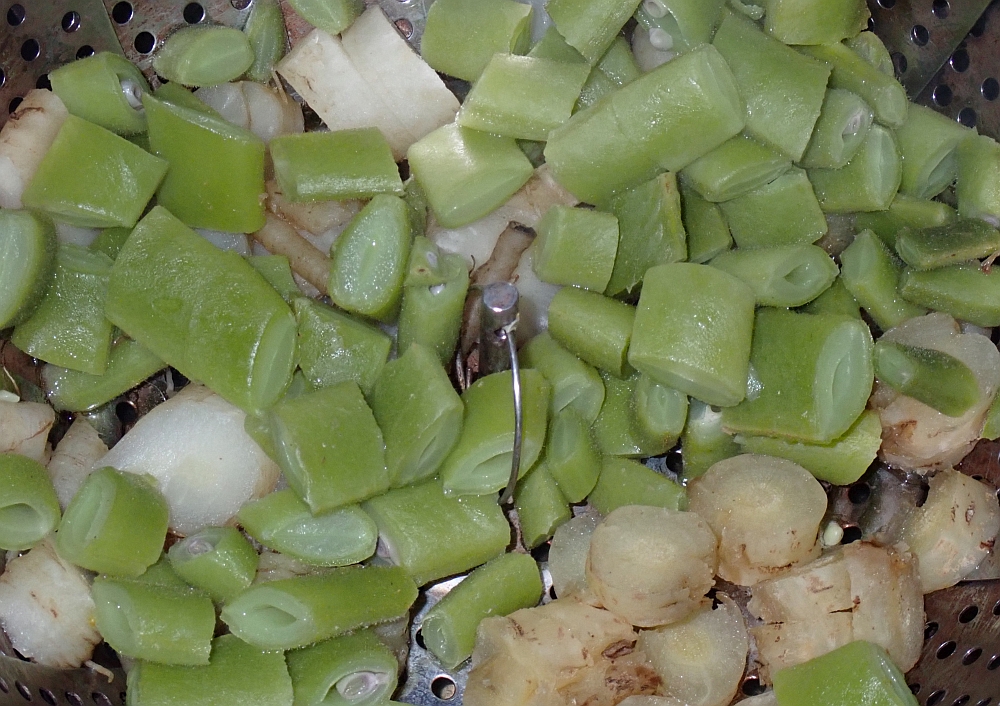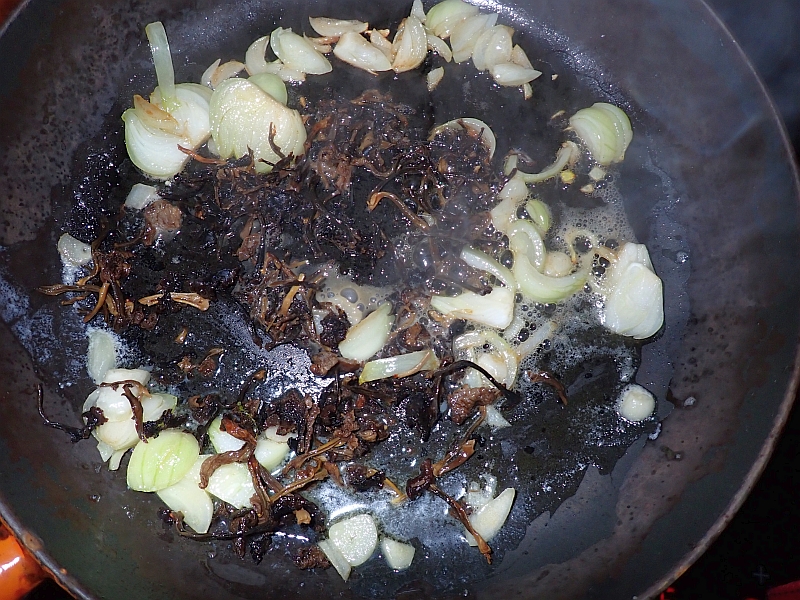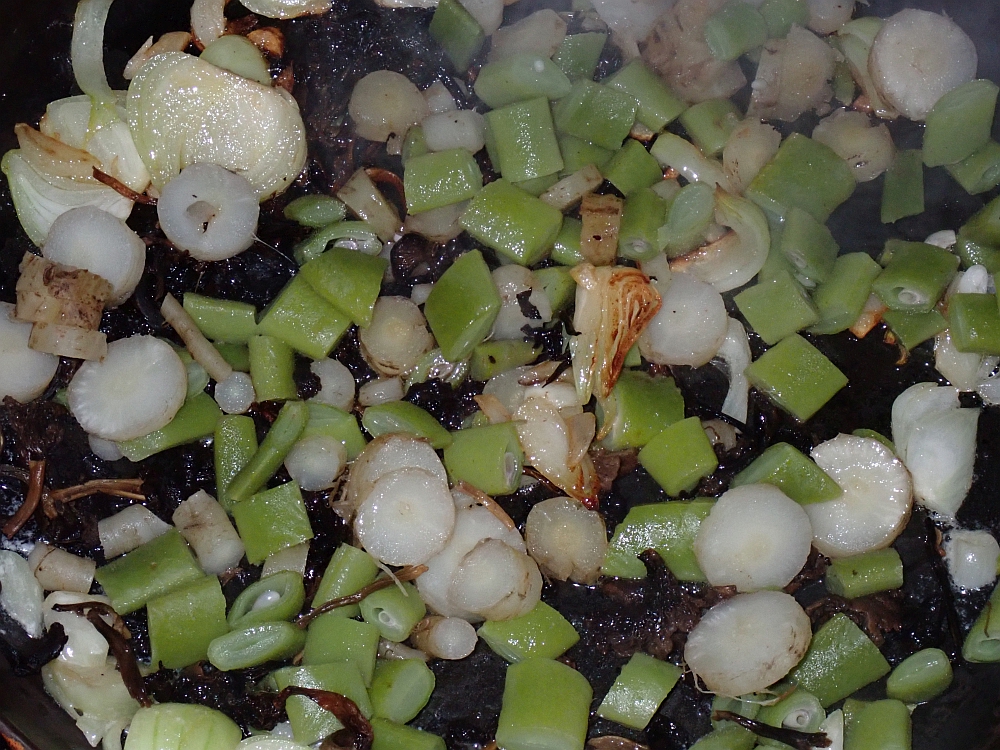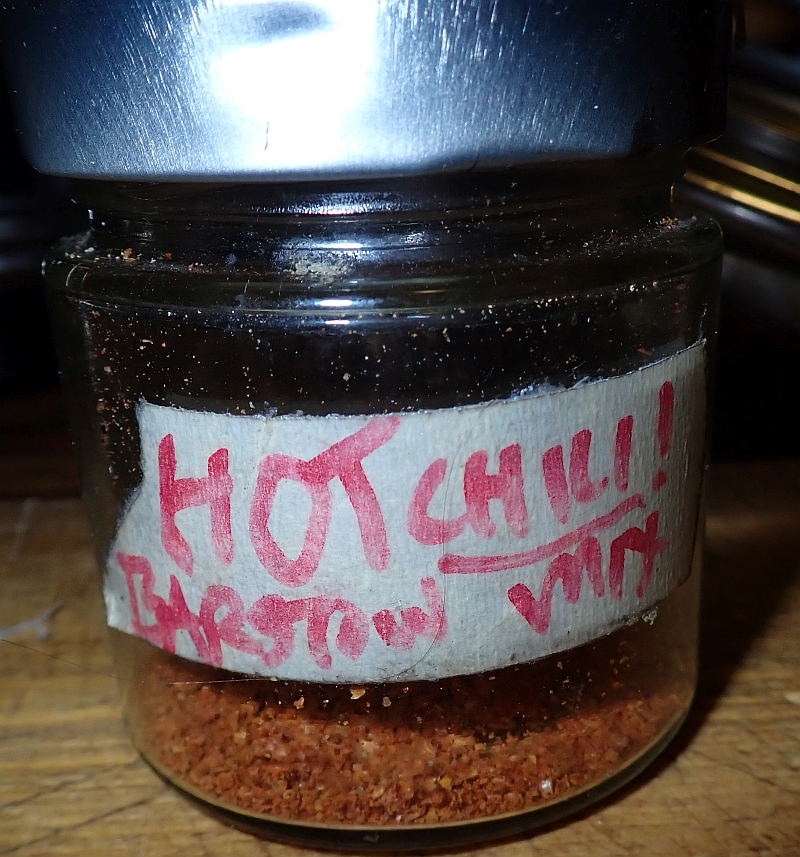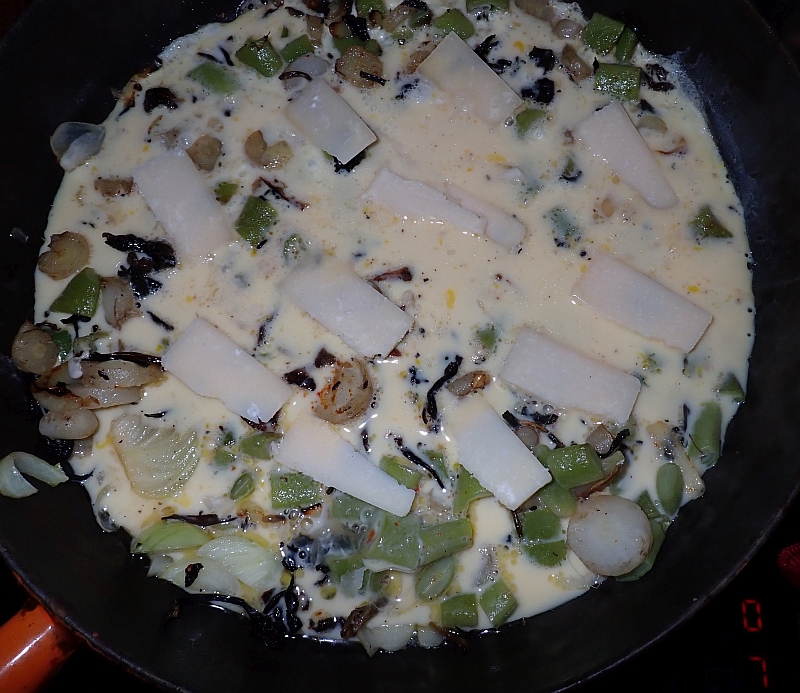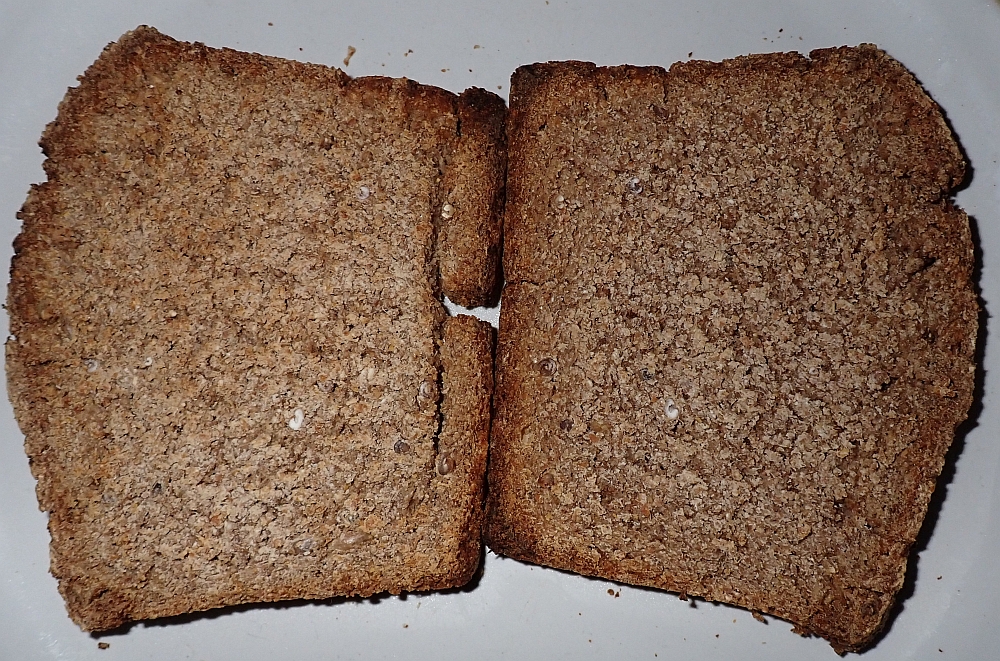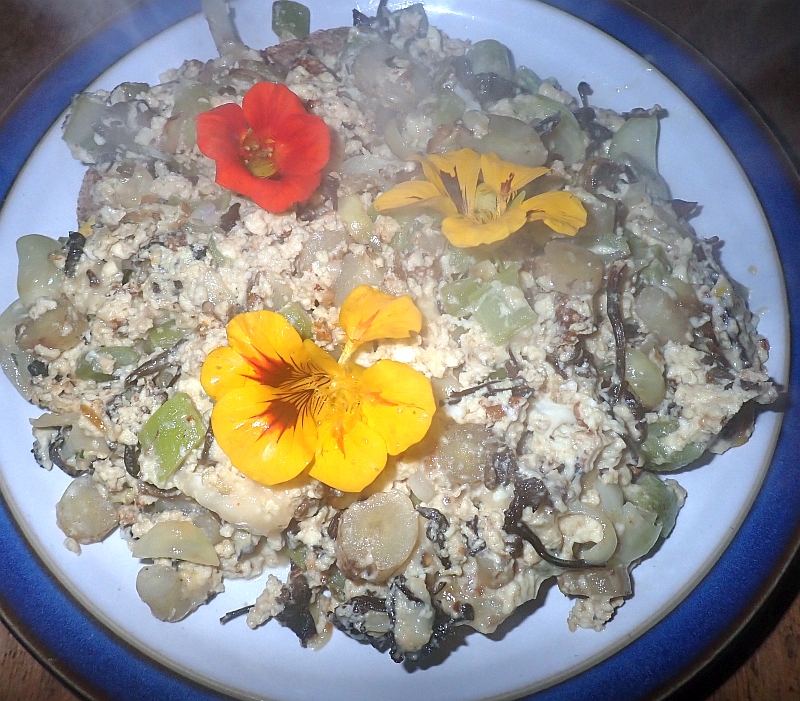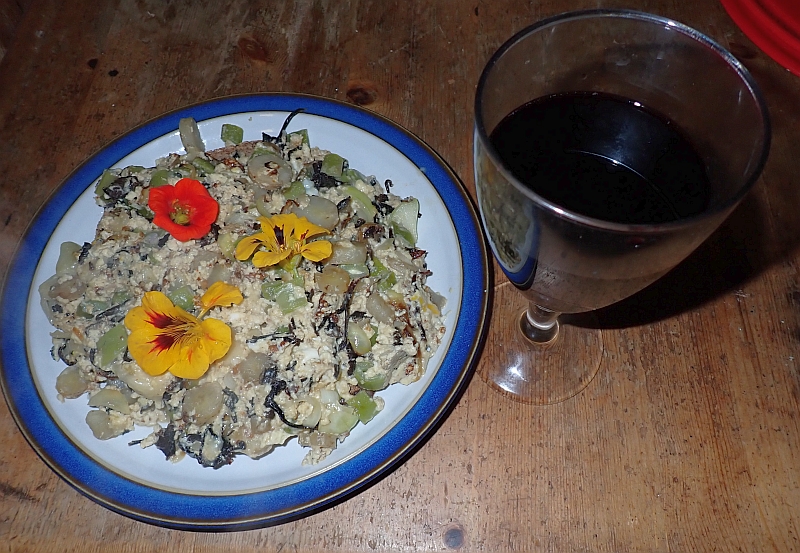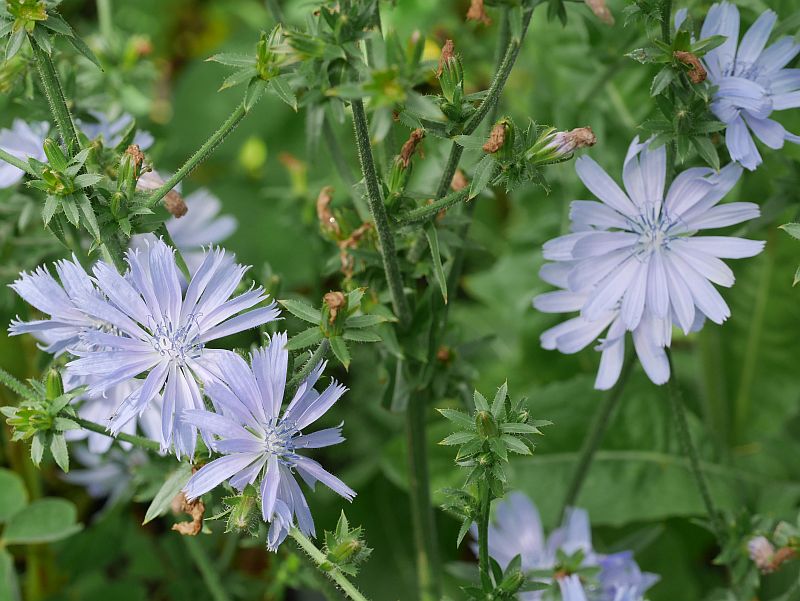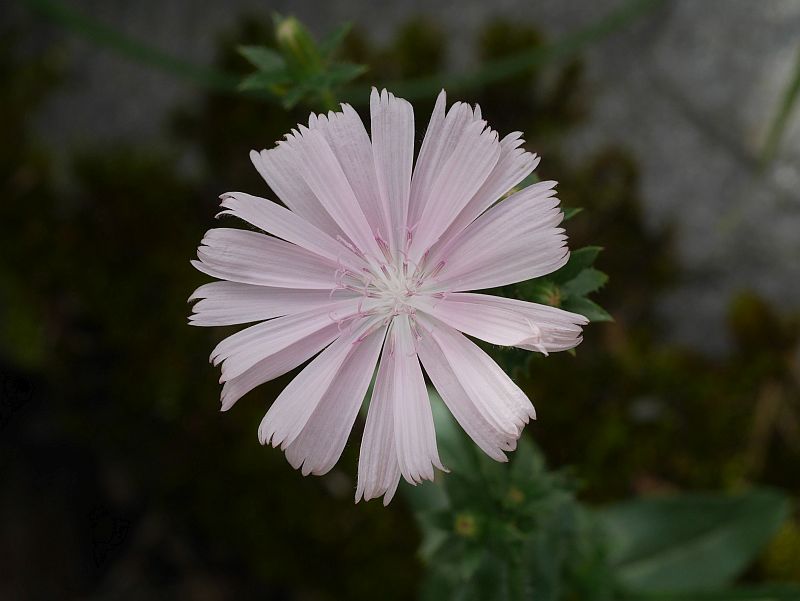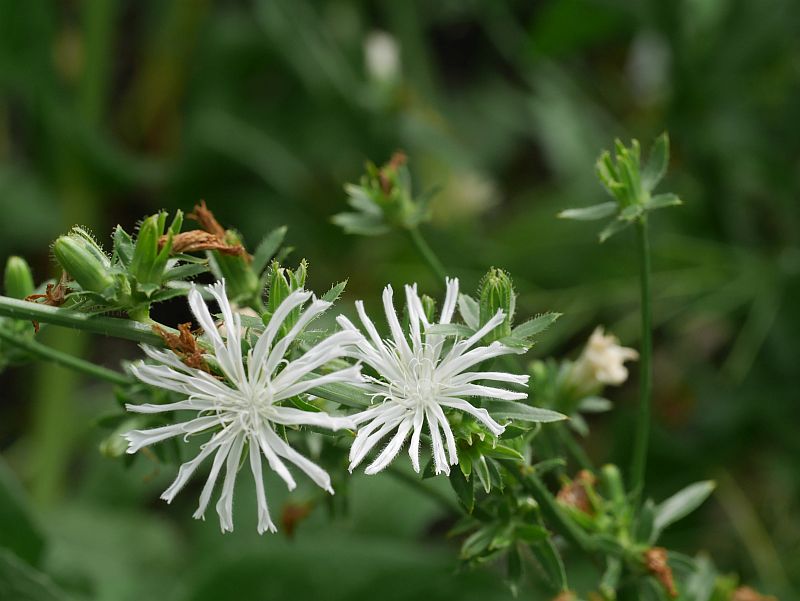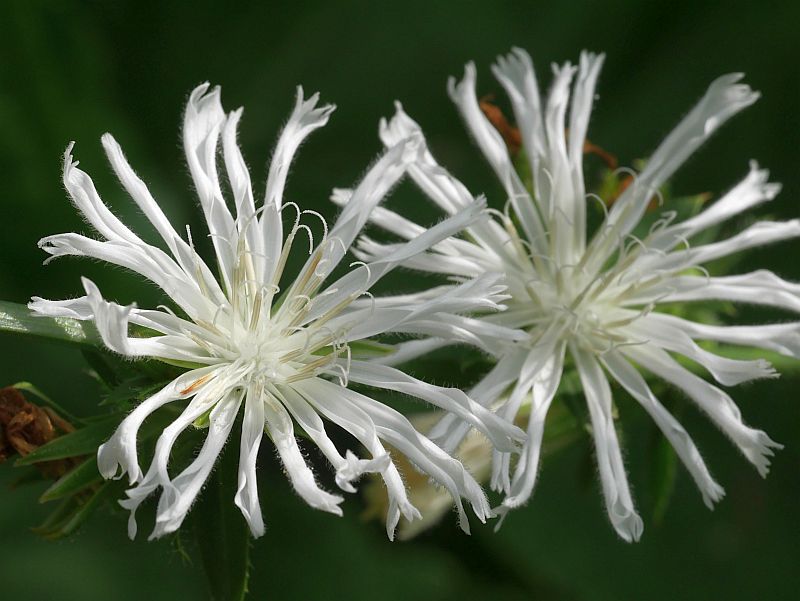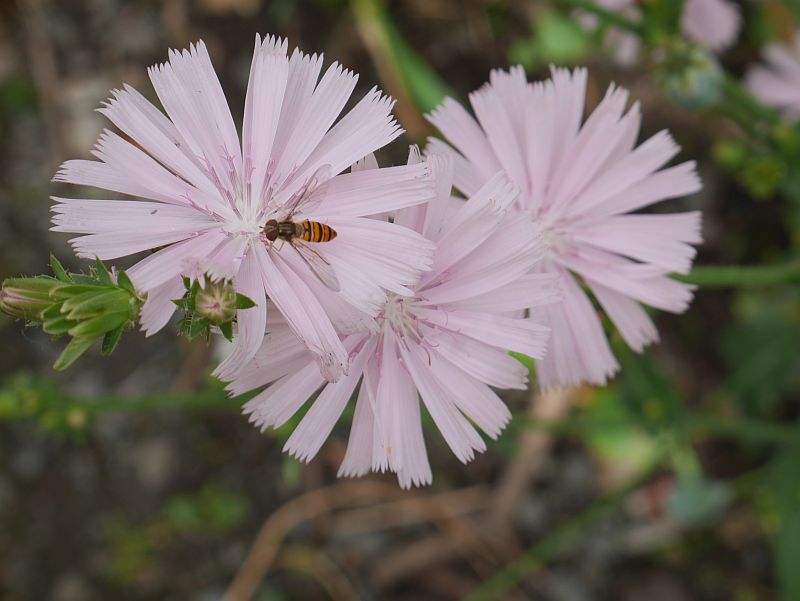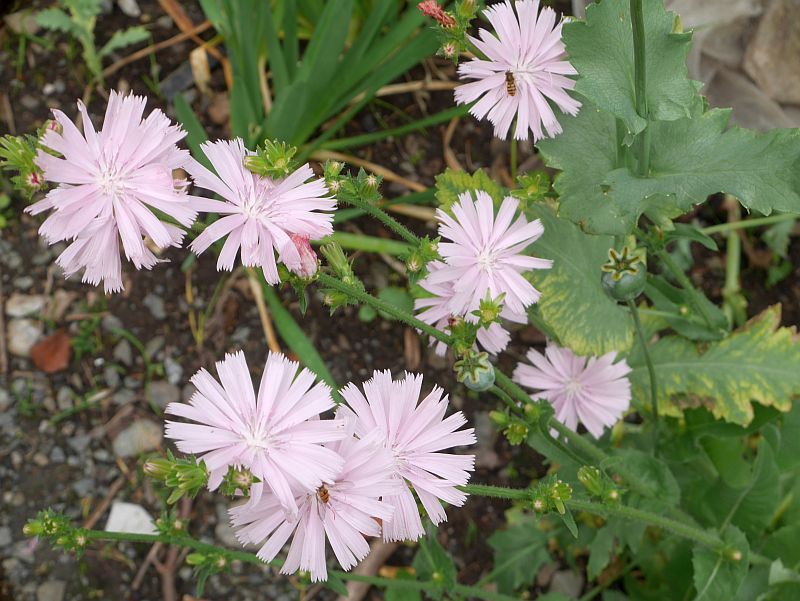I had been asked if I had photos of the roots of chicory (sikkori) and sweet cicely (Spansk kjørvel) for a talk about wild edible roots. I therefore dug some from the garden.
Inspired by traditional Mediterranean ways of preparing wild and cultivated vegetables, I boiled the roots and they were then stir-fried with onions and winter chantarelle mushrooms before being added to scrambled egg (see the pictures for more).
All the roots on the perennial chicory were far too fibrous to eat, but the sweet cicely roots were good (at least the younger ones!)
More or less any vegetable can be prepared this way!
Simple is best!
Tag Archives: sikkori
Cellar and Garden Greens: 6th April 2022
The greens that went into last night’s wholegrain spelt quiche are listed below the picture!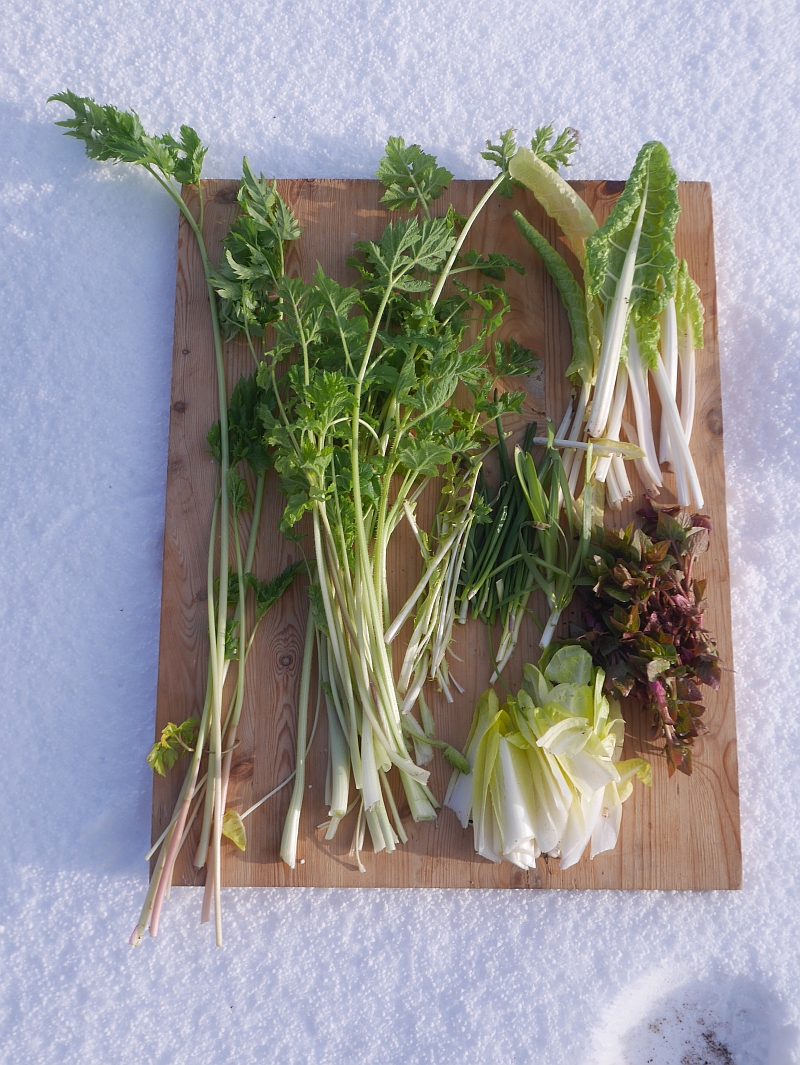 CELLAR: Dystaenia takesimana shoots; Forced hogweed (bjørnekjeks) shoots (Heracleum spp.); Forced Taraxacum (dandelion / løvetann); nederst til høyre: Witloof chicory (sikkori); øverst til høyre: swiss chard (mangold)
CELLAR: Dystaenia takesimana shoots; Forced hogweed (bjørnekjeks) shoots (Heracleum spp.); Forced Taraxacum (dandelion / løvetann); nederst til høyre: Witloof chicory (sikkori); øverst til høyre: swiss chard (mangold)
GARDEN: Various hybrid onions (Allium senescens x nutans) and Hablitzia tamnoides (Caucasian spinach / stjernemelde)
March soba greens
Today it reached an unusually warm 16C here which encouraged the first bumble bees and honey bees out! The picture shows the greens (and whites) used in tonight’s soba (buckwheat noodle) stir-fry:
Hogweed (Heracleum spp.) shoots (far left, from the cellar); top row: Dystaenia takesimana (outside), chicons (chicory shoots; cellar), horseradish shoots (cellar), garlic and Allium scorodoprasum shoots (outside), Allium cernuum shoots (outside); Below from L to R: Dandelion (Taraxacum) shoots from the cellar, ground elder (Aegopodium podograria) shoots (outside), lesser celandine (Ficaria verna), wild buckwheat (Fagopyrum tataricum) seed sprouts (living room), nettle shoots (Urtica dioica), hedge mustard (Alliaria petiolata) and (bottom right) Hablitzia tamnoides shoots.
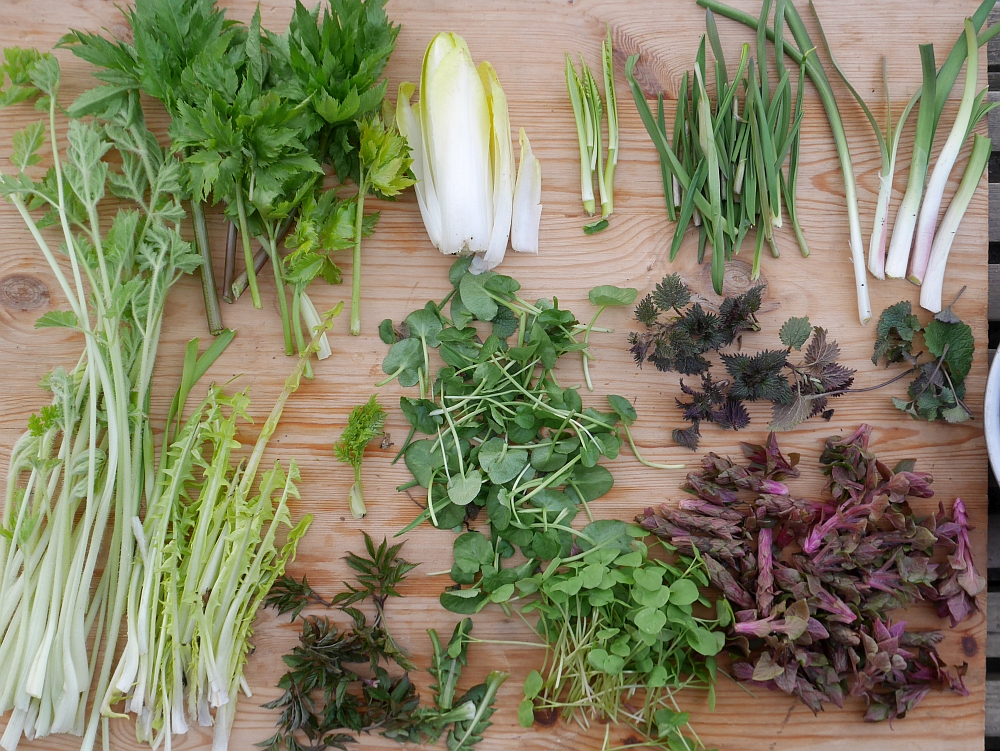
Natural bird food is best
I garden for the birds and other wildlife as well as myself and believe that bought bird food (sunflower seeds) is not necessarily a good thing as it’s imported and largely grown inorganically to the detrement of birds and other wildlife in the country of origin. My observations are that most bird species in our area prefer natural food (including grain in local fields) and several species never or seldom come to bird feeders. Others such as blackcap (munk) are reliant to a large extent on garden berries and fruit.
For these reasons, I put out purchased birdfood including homegrown grain and apples only when the whether is severe. Even here in the north where we have largely had subzero temperatures day and night since November, most birds seem to be finding plentiful natural food this winter. Today, greenfinches (grønnfink) and bramblings (bjørkefink) were feeding on rowan (rogn) berries, I noticed a blue tit (blåmeis) eating nettle seed, waxwings (sidensvans) were taking guelder rose (krossved), hawthorn (hagtorn) and rowan berries (films below), a blackcap was spotted eating one of the last apples still hanging on a tree, fieldfares (gråtrost) were eating hawthorn berries and, for only the second time I noticed goldfinches feeding on chicory (sikkori) seed before switching back to burdock (borre) seed. I grow both burdock and chicory for food and a bi-product of seed saving is that the birds get a share. There are also flocks of siskins (grønnsisik), crossbills (korsnebber) and pine grosbeaks (konglebit) feeding on spruce and pine seed, often in large flocks. Every evening there are maybe a thousand crows (hooded crows / kråke and jackdaws / kaie) that fly into the roost at Vikhammer, still finding grain during our short day in the snow-covered fields. There’s also a local flock of over 90 Canada Geese (Kanadagås) that are overwintering and still able to forage in the fields. There are thousands of wildfowl also on the fjord and I today noted a flock of 250 mallard (stokkand) duck resting in the bay below the house.
Bird feeders can also have negative impact on birds as disease can spread rapidly, such as salmonellosis in greenfinch and house sparrow.
Growing plants in our gardens to supply a greater proportion of winter food for our birds is something many of us can do, but it does mean leaving seed heads to deadhead until spring and encouraging wild plants such as nettles which have multiple uses for us and wildlife. It’s also not as easy as buying a bag of bird seed from the supermarket. Bird friendly plants can be planted in good view of the house. For example, I have a yew tree right next to my kitchen window which allows me to observe berry-eating species such as blackcap, waxwing, robin, fieldfare, redwing and blackbird to within 1m!
I think we should also consider delaying putting out commercial bird food until weather really is severe.
1. Waxwings in slow motion – notice what happens with the rowan berry in the second sequence in the first video:
2. Only the second time I’ve seen goldfinches on chicory:
3. Waxwings on guelder rose berries with bramblings
Unusual October veg
A few unusual vegetables this October from the Edible Garden and House:
1. I’ve been trialling around 20 different chicories this year from seed from the German seed bank IPK Gatersleben. This is one of the best producers, Sugar Loaf (Accession CICH 350) which ended up in yesterday’s Basella and Chicory pizza! I remember years ago on a work meeting in Venice enjoying a chicory pizza.

2. Gunnera tinctoria is the representative for South America in my book Around the World in 80 plants. Sadly, it is not very hardy and mine grows in a large pot half submerged in my small pond and is moved into the cellar for the winter where it goes to sleep for most of the winter. The edible leaf petioles don’t reach the size of plants grown outside and are therefore a bit more fibrous. Their crunchy texture and sweet-sour taste was nevertheless a good addition to a mixed salad earlier in the week. 

 3. This summer was the first time I’d grown Okinawan spinach (Gynura bicolor). I cut it down earlier this week and used the leaves in the mixed salad together with the Gunnera. It’s the variety with red undersides to the leaves. Thanks to my friend Kim Jacobsen who leads KVANNs Stueplantelaug (Norwegian Seed Savers’ (Edible) House Plant guild) for sending me cuttings. It looks and tastes good!
3. This summer was the first time I’d grown Okinawan spinach (Gynura bicolor). I cut it down earlier this week and used the leaves in the mixed salad together with the Gunnera. It’s the variety with red undersides to the leaves. Thanks to my friend Kim Jacobsen who leads KVANNs Stueplantelaug (Norwegian Seed Savers’ (Edible) House Plant guild) for sending me cuttings. It looks and tastes good!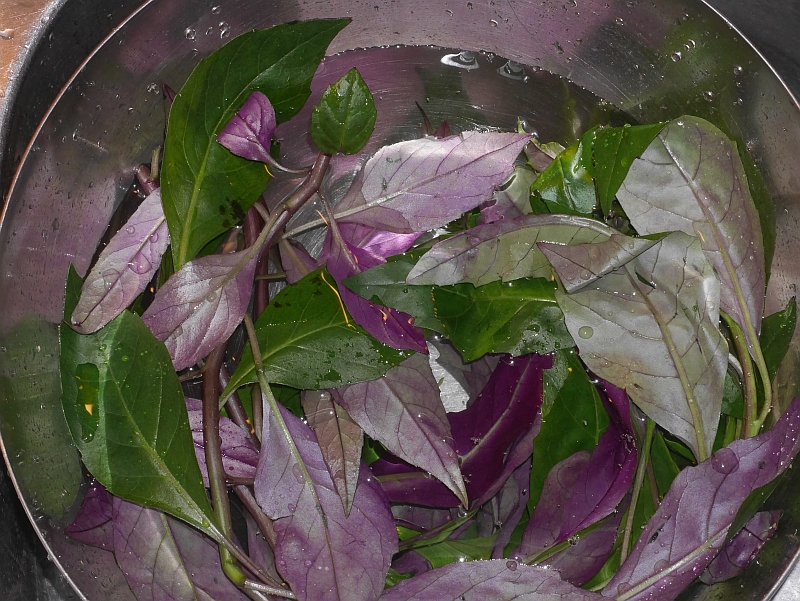

4. I also grow Basella (Ceylon spinach) inside and it always produces berries and seeds for the following year and for sharing. This was used with the chicory (above) in the pizza.
5. Autumn is also the time that the perennial kales resprout and provide an abundance of greens. Here’s a video of the perennial kales in the Edible Garden this week. I have another similar sized plot at the community garden.
6. One of my favourite wild edibles is common sow thistle / haredylle (Sonchus oleraceus), although I deliberately cultivate it. However, apart from posts by myself, this is a plant that isn’t mentioned in Norwegian foraging groups in Norway. Is this because it needs some preparation in order that it’s merits can be properly understood, the bitterness maybe putting people off at first taste? This is a plant I devote several pages to in my book Around the World in 80 Plants and I document how this is an important wild edible worldwide. My introduction to its merits was in the book Native Edible Plants of New Zealand by Andrew Crowe and on a work trip to that country in the early 2000s I could see for myself how important this plant is for the Maori people with over 1/3 of all the vegetable stalls selling this plant. Known as puha to the Maori, it has become a so-called cryptocrop* of the Maori vegetable gardens, an annual “weed” introduced by the Europeans with a similar taste to the traditional perennial endemic sea-cliff inhabiting puha (Sonchus kirkii). Annual puha is encouraged in between the main crops as it has a cash value and increases the yield of the land. It has also been suggested that the large consumption of annual puha by the Maori (hardly used by people of European descent) protects them against some forms of cancer. I was so inspired by the story of how a plant much hated worldwide could at the same time be a superfood appreciated by the Maori and all the other peoples around the world who are in the know, that I introduced it to my garden and it is now become my most important vegetable from late July to the first frosts! From it becoming a burden to weed out this coloniser of open soil, I now weed this “weed” leaving only a few plants to grow strong on the edges of my vegetable beds….and hate is turned to love! Much more in my book!
*Crytocrops: a distinction has been made between cryptocrops
from weeds by Diego Rivera et al. in a 2006 paper: “This led us to distinguish cryptocrops from weeds. Both are not cultivated plants living in crop fields and competing with the main crop. The fundamental distinction is the intensity of gathering by man”.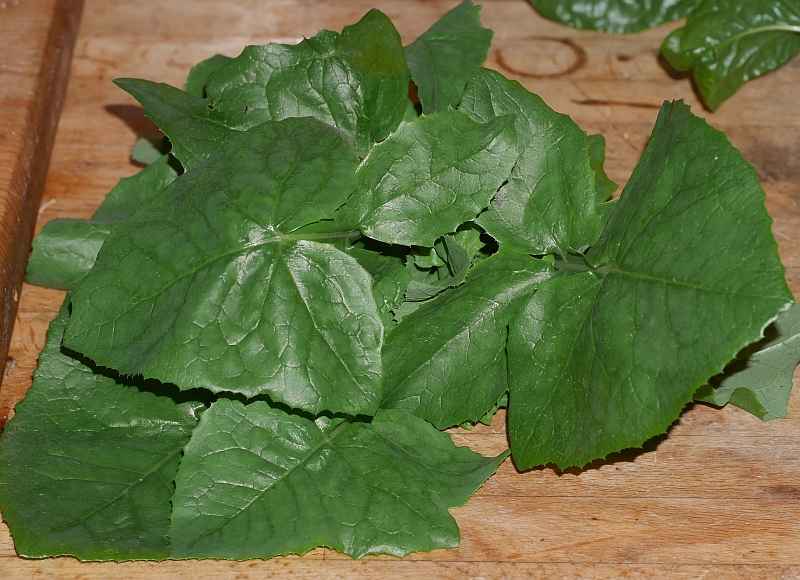 7. I have a special fascination for vegetables that are superstars in one part of the world but hardly known in their area of origin and one of those is garland chrysanthemum or crown daisy (Glebionis coronaria, early known as Chrysanthemum coronarium). This is a wild and extremely common flower of early spring in Mediterranean countries, often growing in large quantities, and commonly available in supermarkets in Japan where it’s known as shungiku. See more on this blog post Shungiku soba (a standard offering in soba restaurants in Japan): https://www.edimentals.com/blog/?p=22710
7. I have a special fascination for vegetables that are superstars in one part of the world but hardly known in their area of origin and one of those is garland chrysanthemum or crown daisy (Glebionis coronaria, early known as Chrysanthemum coronarium). This is a wild and extremely common flower of early spring in Mediterranean countries, often growing in large quantities, and commonly available in supermarkets in Japan where it’s known as shungiku. See more on this blog post Shungiku soba (a standard offering in soba restaurants in Japan): https://www.edimentals.com/blog/?p=22710
There is a legend that Marco Polo introduced pasta to Italy from China. In an article “Fra Malta til Japan og tilbake” (From Malta to Japan and back again) that I wrote 15 years ago for a Norwegian herbal magazine Grobladet in 2006, I suggested that Mr. Polo gave chopsuey greens in return (see and download the article here https://www.edimentals.com/blog/?page_id=3493).
When I first wrote about shungiku in 2006, I could only find one reference of its use in the Mediterranean for food. Since then, there have been carried out numerous ethnobotanical studies throughout the Mediterranean and a quick search carried out now revealed that this plant has been used traditionally throughout the area, although by no means a common wild edible:
In Turkey: numerous studies (leaves, young shoots and stems are used) have recorded this plant used as summarized in a paper from 2019 by İsmail Şenkardeş and others: “An Ethnobotanical Analysis on Wild Edible Plants of the Turkish Asteraceae Taxa”
In addition, it is recorded in two studies in Spain, in Morocco, Palestine and in Sicily it was both cooked and used in salads.
This plant fits nicely into my diversity cooking as it produces new shoots in smaller amounts throughout the summer from July to the first frosts and they are usable even after the plant has flowered and produced seed.
There are many cultivars with different flower colour, double and single and serrated and whole-leaved forms. I’ve grown some 10-15 different cultivars this summer, the seed from the collections at IPK Gatersleben in Germany.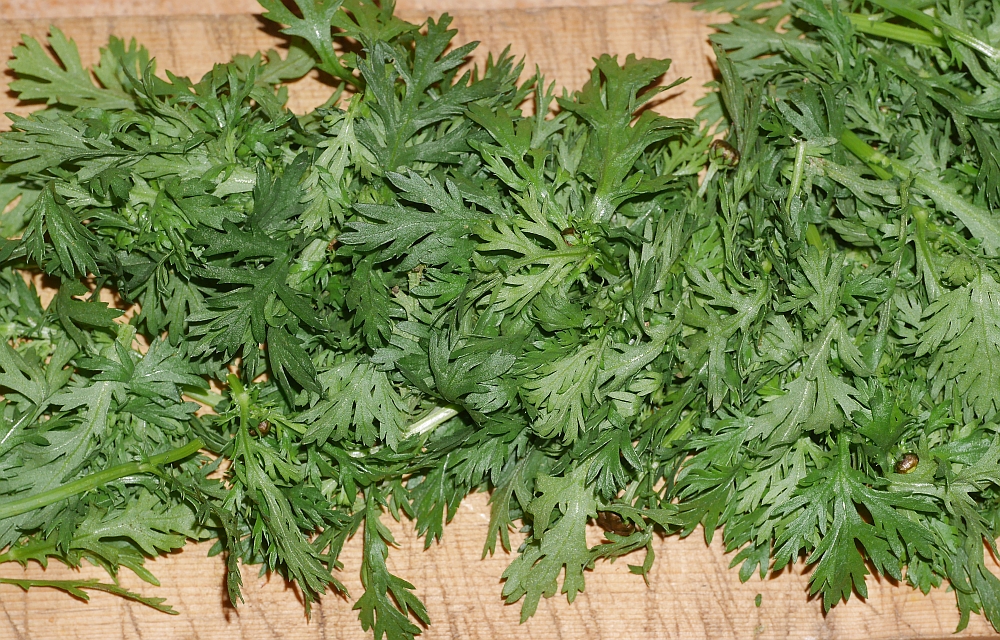

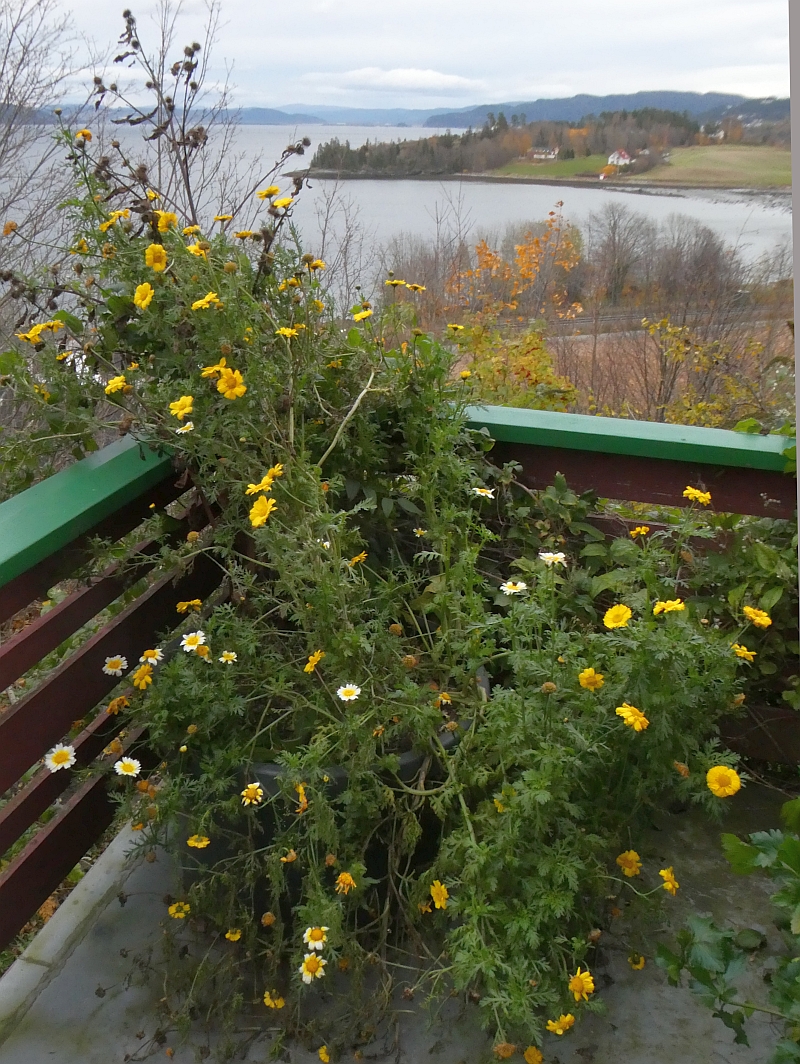
The winter’s first salad shoot salad
The salad was decorated with Begonia flowers from the living room!
